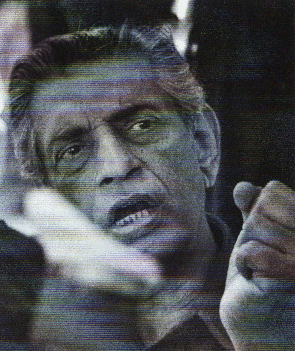Cinema
"Calcutta is a city with a soul...The contrast between the Bombay and Calcutta movie industries more or less sums it up. While Bombay, the Hollywood of India, churns out movies of amazing tinsel banality, the smaller number of movie makers in Calcutta make noncommercial gems that stand up to anything produced for sophisticated Western audiences."
India - a travel survival kit, 5th edition,
Lonely Planet Publications, Australia
As far as cinema is concerned, Calcutta is to India what Cannes is to France. With over a hundred movie theaters, little needs to be said about the enthusiasm of Calcutta's citizens when cinema is concerned. Calcutta has some of the finest theaters in this part of the world. These include the modern Nandan cinema complex with its two theaters, and the grand old cinemas of the colonial age. These include the New Empire Theatres, the hall that screened the first 'talkie' show in the 1930s, and still as opulent, the neighboring Lighthouse, the Globe, Chaplin, formerly Minerva, and the now derelict Metro. Calcutta's theaters screen a large number of western movies, not dubbed in local languages, as seems to have become the custom in other cities in the region, but in the original language.
Calcutta's film industry was born in the 1920s in what used to be the suburbs of Tollygunge in the south. Calcutta's citizens were first exposed to locally concocted matinee magic at about this time. The Gramophone Company of India opened its first recording studio here in Calcutta at a time when there were no recording facilities anywhere outside England, including Hollywood. The factory continues to be the largest music factory to this day. Whatever Calcutta's early cinematic achievements may have been, Calcutta's film industry came of age in the 1950s when Satyajit Ray began one prize after the other at various film festivals worldwide as a director. Other directors, like Tapan Sinha, Ritwick Ghatak, Mrinal Sen and Aparna Sen followed and Calcutta built its reputation as a producer and connoisseur of art cinema.
The Calcutta Film Festival is held every fall is an international event and is attended by the likes of Kurosawa, Antonioni and Bertolucci all personal friends of the late Satyajit Ray, who was awarded an Oscar for life time achievement shortly before his death in 1992. The India International Film Festival, the venue of which changes every year, is regarded as a success only when it is held in either Calcutta or Trivandrum, inviting consideration by the authorities that it may be held permanently in these two cities. Nandan is the venue of smaller film festivals round the year, and I must say that tickets to the 3000-seater hall are hard to come by, even for a Slovak film festival, in a city where not too many people speak that language.
Calcutta's commercial cinema has taken a beating recent days and the studios in Tollygunge are all but gone. Nevertheless, Tollygunge has produced some memorable hits in the 1950s, 1960s and 1970s they still run to full houses to this day, next to the latest releases of Hollywood blockbusters, and the prizewinners from Berlin and Cannes. The duo of Suchitra Sen and Uttam Kumar, who acted as real life people at a time when Bombay brought forth James Bond style superheroes, remain extremely popular until this day.

Satyajit Ray, the most famous film director from Calcutta. His fame and respect in international film circles can be gauged from the fact that the organizers of the Academy Awards broke their tradition since inception, by flying down to Calcutta to award him the Oscar for Lifetime Achievement as he lay on his deathbed in 1992.